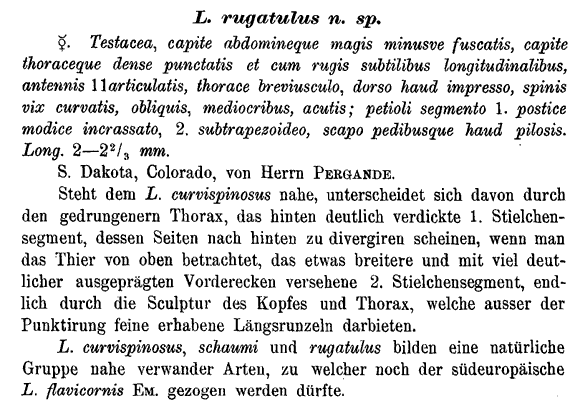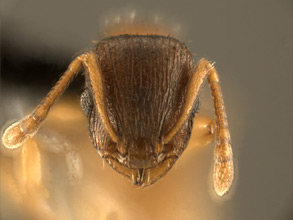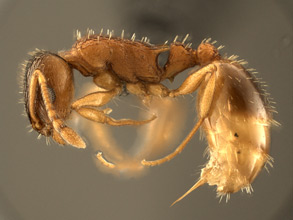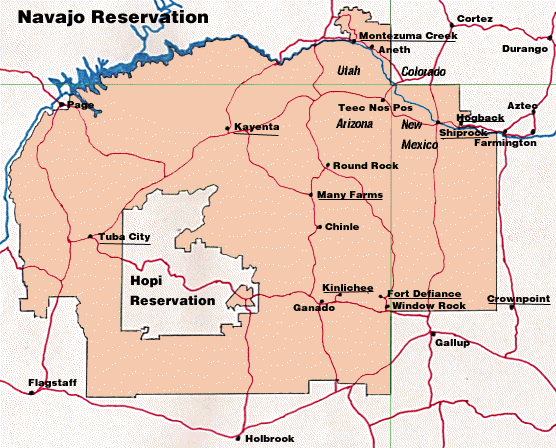- Identification
- Ants of the genus Temnothorax are small, with a head that is elongate relative to their mesosoma, and have an 11 or 12 segmented antenna that ends in a 3 segmented club. The mesosoma has no, or only minor, depressions along its dorsal surface and the propodeum either bears two small tooth-like projections or two true spines.
- Temnothorax rugatulus workers are concolorous yellowish-brown. This is the only Navajo Reservation Temnothorax with an 11 segmented antenna. It also has well developed propodeal spines and coarse rugosity on the head, the top of the mesosoma and the petiole.
- Biology
- Modified from Mackay (2000): Higher elevation coniferous forest species which occurs in moist habitats, in shaded grassy slopes with pines or grasslands. This species also reaches into pinyon-juniper and cool desert habitats. Nests have been found in the soil, under rocks, in decaying wood, in grasses and in trees.
- Distribution
- Range
- Canada and United States. Washington, Oregon, Idaho, Montana, North Dakota, South Dakota, Wyoming, California, Nevada, Utah, Colorado, Arizona, New Mexico, Texas and British Columbia.
- Navajo Reservation Records
- Collection records being processed.
- Additional Notes
- Queen morphs, colony founding and colony social structure.
- There are known to be both macrogyne and microgyne Temnothorax rugatulus queens (Rüppell et al 1998). The large queens are nest founding specialists, and a majority of monogynous colonies are headed by a single queen of this type. Microgynes, with the smaller body reserves, are predominately found in polygynous colonies. Genetic analysis shows they are preferentially readopted into their natal colony.
- Flight characteristics of the two forms support the hypothesis that queen morphs employ different post mating nesting strategies. Larger macrogyne queens were more often found in flight traps, suggesting they are more likely to take flight either to find a mate or to search for a location to start a new nest.
- Etymology
- Morphological. A reference to the rugosity found on the body. L. rugatus = wrinkled + L. -ulus = somewhat
Original Combination - Leptothorax rugatulus - Emery 1895.

- Literature
- Emery, C. 1895. Beiträge zur Kenntniss der nordamerikanischen Ameisenfauna. (Schluss). Zoologische Jahrbücher, Abteilung für Systematik, Geographie und Biologie der Tiere. 8:257-360.
- MacKay, W. P. 2000. A review of the New World ants of the subgenus Myrafant, (Genus Leptothorax) (Hymenoptera: Formicidae). Sociobiology. 36:265-444.
- Rüppell, O., J. Heinze, and B. Hölldobler. 1998. Size-dimorphism in the queens of the North American ant Leptothorax rugatulus (Emery). Insectes Sociaux. 45:67-77.
- A note about these publications. The literature cited here is not meant to be an exhaustive list of papers published about this species.
Page authored by David Lubertazzi and Gary Alpert


